Language Arts:
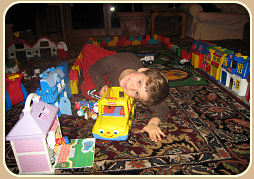 |
Creating a city out of blocks & toys |
Language art in the preschool years is defined by the young person's ability to recognize the relationships between the written and spoken systems as a way to communicate.
Infants learn to recognize expressions on faces . They also learn sign language as a way to express their needs and desires. As they grow into toddlers, they begin to mimic speech and gestures to get their point across.
Reading, storytelling, and dramatic play are the building blocks to teaching young pre-schoolers the art of communication. The more time they spend playing in these types of activities, the easier their language skills will become for them. Therefore, practicing their social skills with other people will seem natural and fun.
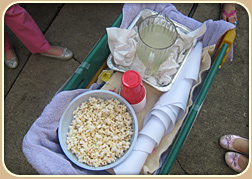 |
Popcorn and lemonade stand |
The Makeovers Pre-School Curriculum Language Arts section is designed to create a comfortable environment by teaching the adult how to present the language arts, storytelling, and dramatic play concepts to the child. Practice with these tools on a regular basis and watch your child grow into these skills with confidence and ease. Storytelling:
The art of storytelling has been around for thousands of years. Storytelling was a favorite pastime of people long before books were invented. The art of storytelling starts with an outline of the major events in the tale you want to tell. Using different character voices and exaggerated gestures makes the story fun for young children. Practicing the same stories over and over again makes storytelling skills sharp. Adding props like a blond doll and three bears to your Goldilocks story makes it exciting and fun.
In the Makeovers Home Preschool curriculum, you find a list of timeless tales that you may use. Read the stories and try to commit them to memory. The more you practice, the more you remember each time. You also find an outline on how to tell the stories and which props to use, when to make the exaggerated gestures, and when to change the style of your voice to play the character.
Inventing your own stories to tell or making a favorite book into a storytelling adventure is encouraged. Use the outlines in this notebook to help you get organized in telling your story.
Repeat the same stories to your children. Children learn best through repetition. Once you've mastered some of the stories, teach your child to tell the story with you to someone else or a whole audience of willing family members and friends.
Keeping the art of storytelling alive in your own family is a great way to share family time and to make good memories.
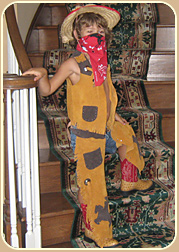 |
Playing dress up: Cowboy |
Dramatic Play:
Dramatic Play is the art of pretending. Children do not distinguish between fantasy and reality. Their minds swim easily between fantasy and reality as if they were made of the same fabric. Creating a strong connection to their imaginations leads to many years of teaching them how to play.
Children that have been taught how to pretend are highly creative. They can create a game out of anything. Once this wondrous skill is learned by a child, he/she has the ability to create new games and scenarios on their own. For example, such games as Safari, camping, veterinarian's office, and pet store bring stuffed animals to life and create a wonderful world in the child's imagination. Children who know to play pretend also learn how to work at an early age. Setting up dramatic play scenes like restaurant, grocery store, and doctor's office takes work and patience.
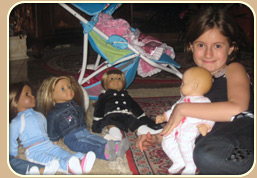 |
Playing "Mommy"
with her dolls |
There are many steps in creating these pretend places and once a child has set them up, they will love to do it again and again. For some children, setting up these games is half the fun.
Makeovers Pre-School Curriculum Language Arts section has many tools on how to teach your children to pretend. Help them set up these games and watch imaginations and excitement grow as they learn to do it by themselves and then, in turn,
teach their friends as well.
Makovers Curriculum samples are viewable with Adobe Reader. If you need to download Adobe Reader, click the Get ADOBE READER button. The Adobe Reader download page will open in a new window.
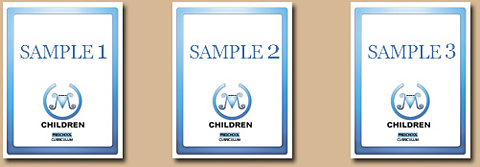
|








